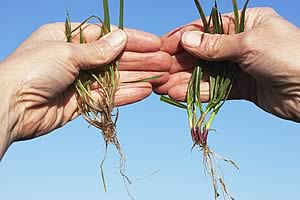 |
|||||||||
|
|||||||||||||||||||
Do
Your Swards Pass The Stem Base Test? Winter is the ideal time to assess grazing sward quality and determine your reseeding priorities, and this will be all the more important this year following a dry summer that will have exposed less productive fields.
“As a general rule ryegrasses have a red colouration at the base of the stem and weed grasses do not,” he says. “It is therefore easy to work out the level of weed ingress in a sward simply by pulling up a random selection of plants all over the field and working out the relative proportion of ryegrasses to weed grasses. To be doubly sure, check that the underside of the leaf is shiny – if you have the combination of a red stem base and shiny underside on the leaf, that’s a ryegrass! “Weed grasses such as the meadow grasses, creeping bent and Yorkshire fog, for example, are less productive, lower in quality and less responsive to nitrogen than commercially bred ryegrasses, so any level of ingress is going to reduce the productivity of your sward. As a guide, swards should contain at least 60% of their originally sown species, otherwise it is probably time to reseed or at least rejuvenate the sward with over-seeding.” Other factors to take into account should include any evidence of bare ground, plus observations made during the growing season such as the level of non-grass weeds present. “Bare ground in a grazing sward is both unproductive and an opportunity for weeds to establish, so have a look and take this into account when making your reseeding decisions,” continues Mr Shannon. Whilst seeds such as docks and thistles may no longer be visible, you will have been aware of any serious infestations during the summer months so, again, bring this into the equation and be sure that you focus your reseeding strategy in the areas where most will be gained. “Progress in ryegrass breeding has seen yields increase over the last two decades by an average of 1% per year, and the very latest varieties offer significant quality advantages as well. Furthermore, the inclusion of white clover in grazing swards will contribute 150kgN/ha. An effective reseeding strategy will provide the dual benefits of increased output and reduced feed and fertiliser costs, which must make it one of the more cost effective investments you will make.”
|
|||||||||||||||||||

|
|
||||||||||||||||||
| home | agri-services | pedigree
pen | news | dairy | beef | machinery BPS | property | organisations | site map |
|||||||||||||||||||

